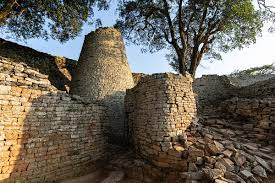Great Zimbabwe is an ancient city in southeastern Africa, located in present-day Zimbabwe. It was the capital of the
Kingdom of Zimbabwe during the Late Iron Age. The city flourished between the 11th and 15th centuries, serving as an important
trading center due to its strategic location between the gold-producing regions and the Indian Ocean trade routes. Great Zimbabwe is renowned for its impressive stone structures, particularly the massive stone walls and the Great Enclosure, which is one of the largest ancient structures in sub-Saharan Africa.
Deep within southeastern Africa lies one of the continent’s most captivating historical sites: Great Zimbabwe. Enigmatic and
awe-inspiring, this ancient city stands as a testament to the ingenuity and architectural prowess of its creators. From its
mysterious origins to its eventual decline, Great Zimbabwe continues to fascinate scholars and travelers alike, offering a
glimpse into Africa’s rich and complex history.
Click here to watch see a short video: https://www.youtube.com/watch?v=5U_jk1bIFfA
The Rise of Great Zimbabwe
The story of Great Zimbabwe begins over a millennium ago, during the Late Iron Age when a sophisticated civilization
emerged in the region. Located in present-day Zimbabwe, Great Zimbabwe served as the capital of a thriving kingdom
that controlled vast territories and played a pivotal role in regional trade networks. Its strategic position between the
gold-producing regions to the northeast and the Indian Ocean trade routes made it a hub of commerce and cultural exchange.
The location of Great Zimbabwe, amidst a semi-arid landscape, posed challenges for its inhabitants in terms of water
management and agricultural sustainability. Yet, the city’s builders demonstrated remarkable ingenuity in adapting to
their environment, utilizing techniques such as terraced farming and rainwater harvesting to support agricultural production.
These innovations enabled Great Zimbabwe to thrive despite its arid surroundings, highlighting the resilience and resourcefulness of its inhabitants.
Architectural Marvels
At the heart of Great Zimbabwe’s allure are its impressive stone structures, which stand as enduring monuments to the ingenuity
of its builders. The most iconic of these is the Great Enclosure, a massive stone wall enclosing an area of nearly 5 acres.
Constructed without the use of mortar, the walls of the Great Enclosure are a marvel of engineering, comprising thousands of carefully placed granite blocks, some weighing over a ton.
Beyond the Great Enclosure, the site is adorned with other remarkable features, including the Conical Tower, a cylindrical
structure rising over 30 feet high, and the Valley Ruins, a series of terraces and platforms nestled amidst the natural landscape.
Each of these architectural elements reflects the skill and vision of the craftsmen who shaped them, providing insight into the social and political organization of Great Zimbabwe society.
Trade and Cultural Exchange
One of the key factors behind Great Zimbabwe’s prosperity was its role as a center of trade and cultural exchange.
Traders from distant lands, including the Swahili city-states along the East African coast and Arab merchants from the Arabian
Peninsula, journeyed to Great Zimbabwe to exchange goods such as gold, ivory, and ceramics. This vibrant trade network
facilitated the spread of ideas, technologies, and artistic influences, enriching the cultural tapestry of the region.
Beyond its economic and political importance, Great Zimbabwe held immense cultural significance for its inhabitants. The
city served as a center of religious worship, with evidence of ritual activities and spiritual practices embedded within its stone structures. Artifacts such as pottery, sculptures, and figurines unearthed at the site offer glimpses into the beliefs, traditions, and daily lives of the people who called
Great Zimbabwe home.
The Decline of Great Zimbabwe
Despite its remarkable achievements, the decline of Great Zimbabwe remains shrouded in mystery. By the 15th century, the city had been largely abandoned, leaving behind a legacy of unanswered questions. While scholars have proposed various theories to explain its demise, ranging from environmental factors to political upheaval, the exact reasons remain elusive. Nevertheless, the legacy of Great Zimbabwe lives on, inspiring curiosity and fascination among those who seek to unravel its secrets.
The artisans of Great Zimbabwe were renowned for their skill and craftsmanship, as evidenced by the intricate stone carvings and decorations adorning the city’s structures. These artistic achievements not only showcased the technical prowess of the craftsmen but also served as expressions of cultural identity and prestige. Symbolic motifs such as the Zimbabwe Bird, a carved soapstone sculpture found at the site, have become iconic representations of Zimbabwean heritage.

Preserving the Legacy
Today, Great Zimbabwe is recognized as a UNESCO World Heritage Site, preserving its cultural and historical significance for future generations. Archaeological research and conservation efforts continue to shed light on the mysteries of this ancient city, offering new insights into Africa’s rich and diverse heritage.
Great Zimbabwe’s legacy extends far beyond its physical ruins, shaping the cultural identity and national consciousness of present-day Zimbabwe. The site serves as a symbol of pride and inspiration for Zimbabweans, representing a shared heritage and a testament to the achievements of their ancestors. Additionally, Great Zimbabwe has left an indelible mark on African history and archaeology, influencing scholarly discourse and sparking interest in the continent’s pre-colonial civilizations.
Great Zimbabwe stands as a testament to the creativity, resilience, and innovation of the African civilizations that flourished in
the pre-colonial era. Its majestic stone structures and rich historical legacy serve as a reminder of the continent’s deep and
enduring contributions to human civilization. As we continue to explore and study Great Zimbabwe, we are reminded of the
importance of preserving and celebrating Africa’s cultural heritage for generations to come.
Plan your journey to Southeastern Africa today and prepare to be amazed by this iconic marvel of Great Zimbabwe.
Read More: https://placesandlifestyle.com/exploring-the-mysteries-of-egypt-the-valley-of-the-kings/




